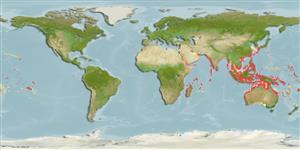Malacostraca |
Decapoda |
Portunidae
Environment: milieu / climate zone / εύρος βάθους / distribution range
Οικολογία
; Υφάλμυρο; εύρος βάθους 0 - 50 m (Αναφ. 343). Tropical; 26°C - 30°C (Αναφ. 111153), preferred 25°C (Αναφ. 107945); 34°N - 37°S, 22°E - 134°W
Indo-West Pacific. Introduced in Hawaii and USA.
Length at first maturity / Μέγεθος / Weight / Age
Γεννητική Ωρίμανση: Lm 6.9, range 8 - ? cm Max length : 28.0 cm CW αρσενικό/απροσδιόριστο; (Αναφ. 343); μεγ. δημοσιευμένο βάρος: 3.0 kg (Αναφ. 343)
Carapace smooth, with strong transverse ridges; H-shaped gastric groove deep; relatively broad frontal lobes, all more or less in line with each other; broad anterolateral teeth, projecting obliquely outwards. Well-developed present on outer surface of chelipedal carpus and anterior and posterior dorsal parts of the palm. Color: carapace green to almost black; legs may be marbled.
Maximum carapace width: between 25 and 28 cm. Maximum weight between 2 and 3 kg. Also collected by baited wire mesh pots. Sold in Taiwan, Hong Kong and Singapore, where the large crabs (so called "meat crabs") and females with ripe ovaries ("roe crabs") command a price from US$5 to US$10 per kg. Largest exporters of this species are Indonesia, Sri Lanka, India, and Bangladesh. There have been attempts to culture the crabs in captivity, but none of the closed-cycle enterprise have gone commercial. Tide is relied upon by farms to bring megalopae or late zoeae into grow-out ponds. Prefers oceanic waters, usually found just offshore on soft muddy bottoms (Also Ref. 9773). Can be caught up to 50 m offshore as it migrates offshore to spawn (Ref. 343). Subtidal (Ref. 106854). Digs deep burrows in mangroves and soft substrates in shallow or intertidal waters (Refs. 343, 9773). Found in brackish to sea water (Ref. 77016). Forages at night. Major predator (Also Ref. 128960) of small invertebrates colonizing mangrove swamps (Ref. 8752). Feeds on shrimps, crabs, fishes, and bivalves (Refs. 99886, 102679). Benthic scavenger but prefers oysters (Ref. 9773).
Gonochoric; sexually dimorphic based on secondary characteristics. The male traps the female under its chest, holding the latter with its chelipers, forming a pair. When the female is about to molt, the male releases but remains nearby. After moulting, the female is again trapped by the male and the latter opens its genitals towards the female's abdomen. Coupling may last from seven to twelve hours (Ref. 99880) and occurs at the bottom of the burrows; spawning occurs five weeks after mating. Migration: young crabs (2 cm CL) attend to estuarine waters and leave to enter the mangroves at lengths 7-9 cm for males and 8 cm for females; after which they return to the sea (Ref. 99886).
Ng, P.K.L. 1998 Crabs. p. 1045-1155. In K.E. Carpenter and V.H. Niem (eds) FAO species identification guide for fishery purposes. The living marine resources of the Western Central Pacific. Volume 2. Cephalopods, crustaceans, holothurians and sharks. Rome, FAO. 1998. pp. 687-1396. (Αναφ. 343)
IUCN Red List Status
(Αναφ. 130435: Version 2025-1)
CITES status (Αναφ. 108899)
Not Evaluated
Not Evaluated
Threat to humans
Human uses
αλιεία: Εμπορικό(ά)
FAO - Υδατοκαλλιέργειες: production, species profile; αλιεία: landings, species profile | FishSource | Η θάλασσα γύρω μας
Εργαλεία
Περισσότερες πληροφορίες
PhysiologyΚατανάλωση οξυγόνου
Human RelatedStamps, coins, misc.
Διαδικτυακές πηγές
Estimates based on models
Preferred temperature
(Ref.
115969): 24.5 - 29.1, mean 28.1 (based on 1290 cells).
Ελαστικότητα
Υψηλό, ελάχιστος χρόνος για διπλασιασμό πληθυσμού < 15 μήνες (K=0.43).
Prior r = 1.17, 95% CL = 0.77 - 1.75, Based on 3 data-limited stock assessments.
Fishing Vulnerability
Low vulnerability (21 of 100).
Climate Vulnerability
Moderate vulnerability (37 of 100).
Nutrients : Calcium = 109 [35, 184] mg/100g; Iron = 1.59 [1.21, 1.97] mg/100g; Protein = 20.2 [19.2, 21.3] %; Omega3 = 0.285 [0.185, 0.386] g/100g; Selenium = 48.3 [-31.7, 128.3] μg/100g; VitaminA = 0 μg/100g; Zinc = 1.79 [1.17, 2.40] mg/100g (wet weight); based on
nutrient studies.
